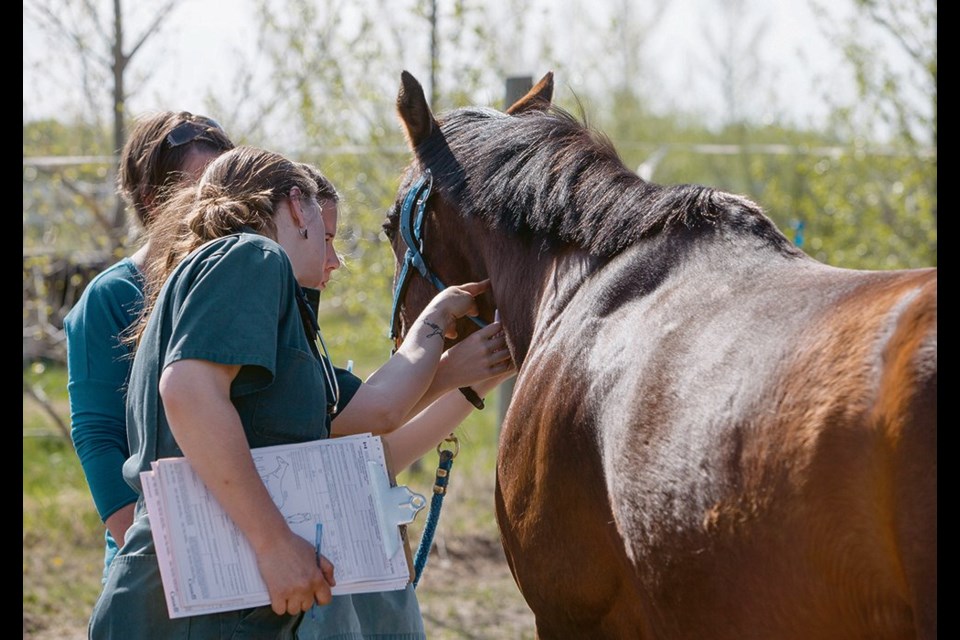SASKATOON — Horse owners near Saskatoon are urged to keep a lookout for equine strangles following recent cases of the highly contagious disease.
Strangles is a bacterial infection of the upper respiratory tract in horses caused by Streptococcus equi subspecies equi (S. equi).
As the slightly sinister name suggests, symptoms relate to abnormal breathing and difficulty swallowing. Other symptoms can include a high fever, loss of appetite, mucopurulent nasal discharge and lymph node abscesses. Horses that are carriers can be asymptomatic.
Dr. Valentina Ragno, a clinical associate with the department of large animal clinical sciences at the University of Saskatchewan’s Western College of Veterinary Medicine, said she is not surprised to see Saskatoon-area cases.
Ragno, a large animal internal medicine specialist, said strangles appears worldwide and is not afraid of cold weather.
“There isn’t a specific season for strangles. Studies have shown that the bacteria that causes strangles can live in a bucket of water for a few weeks — fresh water and clean buckets are critical for prevention.”
She said the perception that many horses are kept to their home barns during winter, which should limit the spread of strangles, isn’t always the case.
“We actually find that there is movement of horses in the winter, whether that’s indoor clinics and competitions or riders who haul-in to another barn with an indoor arena on cold days.”
Strangles is easily transmitted through horse-to-horse contact. The bacteria can live on objects that have come into contact with an infected horse, such as feed buckets, bridles and other tack.
The infection can also be spread by human hands, clothing and equipment, making biosecurity a key component of prevention.
While strangles is not typically fatal, certain complications of the infection can be. “Bastard” strangles involves the development of abscesses in parts of the horse’s body beyond the lymph nodes. Abscesses in the abdomen and brain are particularly dangerous.
Another possible complication is purpura hemorrhagica, a serious immune-mediated reaction that causes inflammation of the horse’s blood vessels (vasculitis). A form of myositis (inflammation of the muscles) is also reported.
Usually, the core vaccinations given to horses in Canada are against eastern-western encephalomyelitis, West Nile virus, rabies and tetanus.
Risk-based vaccines include equine influenza (EIV), equine herpesvirus 1 and 4, and strangles. Horses should also get regular Coggins blood tests for equine infectious anemia (EIA), which is transmitted by insects and is potentially fatal.
In Canada, some owners vaccinate their horses against strangles but some don’t. The main vaccine available is a modified-live bacterial vaccine called Pinnacle I.N. that is given intra-nasally. It can cause mild adverse reactions in the horse and is priced on the higher side.
Ragno said it is up to horse owners to discuss the risks with their veterinarians and do a cost-benefit analysis.
A horse may be at higher risk for strangles if it travels to events and shows or is exposed to other horses that travel. Risk is related to the size of the barn, as well as the human and equine traffic in and out of that barn. Quarantine for new arrivals and horses returning from travel should always be observed.
Younger horses are typically more susceptible to strangles.
“Younger horses need to build up their immunity over time. We see cases as young as four- to six-months-old and often in yearlings. That’s not to say that older horses don’t get it. The large abscesses that impair the horse’s eating, drinking and breathing can have a big impact on a weanling or yearling,” said Ragno.
he said a horse suspected of having strangles must be immediately isolated and handled separately from other horses at the barn. The veterinarian will collect a sample from the respiratory tract to confirm a diagnosis by PCR test.
She suggested attending to the infected horse at the end of chores, and then cleaning and disinfecting all clothing and tools afterward.
Horses that have had contact with the infected horse should have their temperatures taken regularly to detect any new cases.
There’s a debate over letting strangles run its course, and building the horse’s immunity, versus administering antibiotics. A veterinarian will advise what’s best for each individual case. Controlling the fever and ensuring the horse is comfortable enough to continue eating and drinking are always important.
Three weeks after nasal discharge stops, and other clinical signs are gone, the horse is re-tested by scoping its guttural pouches and taking a sample for a PCR test. If all bacteria are gone, the horse can be reintroduced to the herd.
While modified-live bacterial vaccines and antibiotic treatments remain under discussion on a case-by-case basis, barn biosecurity is the first tool in preventing strangles.




